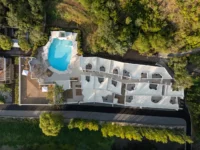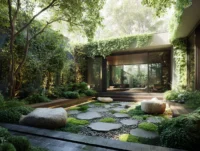If we want students who can solve messy problems, collaborate across differences, and imagine better futures, our buildings have to help. Designing schools that inspire creativity isn’t a luxury: it’s a lever for learning. Spaces shape behavior. The right mix of light, layout, materials, and tools can nudge curiosity, reduce stress, and unlock agency. Here’s how we translate that belief into practical design moves any district can adapt.
The Case For Creativity In School Design
Creativity flourishes when students feel autonomy, belonging, and purpose. Built environments can either constrain or catalyze these conditions. We’ve seen that when classrooms shift from rows-and-lecture to flexible, student-centered layouts, engagement climbs and disciplinary issues drop. It’s not just vibe, it’s cognitive science: environments with natural light, good acoustics, and clear cues reduce cognitive load, freeing up brainpower for problem-solving.
When we design for creativity, we also design for equity and future-readiness. Employers value adaptability and collaboration: students value spaces that reflect who they are. By intentionally shaping circulation, programming, and furniture, we make room for project-based learning, interdisciplinary work, and the quiet focus creativity often requires. Designing schools that inspire creativity is eventually about aligning space with pedagogy.

Core Principles Of Creative Learning Environments
Flexibility And Choice
We plan for multiple modes in a single day: individual focus, small-group collaboration, whole-class dialogue, and playful exploration. Lightweight, movable furniture: writable surfaces on tables and walls: and varied seating (stools, lounge pieces, standing rails) let students choose how they learn. Choice signals trust, and trust fuels risk-taking, a precursor to creative thinking.

Light, Acoustics, And Materials
Daylight improves mood and attention, but glare doesn’t. We combine high-performance glazing, light shelves, and adjustable shading. For sound, we target speech intelligibility by layering ceiling baffles, soft flooring in high-traffic zones, and acoustic panels at first reflection points. Materials matter: warm, tactile finishes (wood, cork, textiles) beat cold, echo-prone hardscapes. Durable doesn’t have to mean sterile.
Nature And Biophilic Elements
Even small doses of nature, views to trees, indoor plants, green walls, lower stress and heighten curiosity. We orient learning spaces to capture outdoor views, add operable windows where feasible, and use palettes inspired by local ecology. Outdoor classrooms and courtyards extend learning into fresh air. Biophilic patterns don’t just look good: they support attention restoration.
Spatial Strategies That Spark Inquiry
Zones For Focus, Collaboration, And Play
We carve a classroom into micro-zones: a quiet nook for deep work, a central collaboration area, and a playful prototyping corner. At the school scale, learning commons adjacent to classrooms become “town squares” for inquiry. Clear visual cues, rugs, lighting, ceiling changes, signal expectations without heavy-handed rules.

Maker Spaces And Studios
Creativity needs mess-friendly rooms. Maker spaces with sinks, robust ventilation, lockable storage, and flexible workbenches invite experimentation. We pair them with adjacent classrooms via large glass openings for visibility and spillover. Art and media studios benefit from controllable light, sound isolation, and tech that supports both analog craft and digital production.
Display And Reflection Areas
When students see their work valued, they push further. Built-in rails, pinup zones, and digital displays turn corridors into galleries. Reflection corners with prompts, “What surprised us? What will we try next?”, normalize metacognition. We also plan movable partitions that double as critique walls to make feedback a ritual, not an afterthought.
Technology, Tools, And Tactility
Analog–Digital Balance
Tablets are great: so are clay, cardboard, and charcoal. We design for both. Writable vertical surfaces encourage standing ideation: tablets capture and iterate. Recording booths enable podcasts: loom corners or robotics carts keep hands engaged. The point is range, students toggle between screen-based creation and tangible making.

Accessible Power, Storage, And Mobility
Nothing kills flow like hunting for outlets. We integrate floor boxes, perimeter tracks, and charging lockers. Mobile power banks and cart-based kits keep tools where the learning is. Deep, labeled storage, and a clear “home” for everything, protects materials and time. Lockable casters on tables and shelves turn a room from seminar to studio in minutes.
Designing For Equity And Well-Being
Neurodiversity And Sensory Needs
We plan sensory gradients. Some students thrive in buzz: others need refuge. Quiet pods, dimmable lighting, and textured, low-contrast finishes reduce overstimulation. Wayfinding with color and iconography helps students who benefit from consistent visual cues. Simple: options, not one-size-fits-all.

Inclusive Wayfinding And Safety
Clear sightlines improve supervision and comfort. We use universal design for signage, high contrast, braille, pictograms, and predictable landmarks. Safety features, access control at entries, visibility without surveillance theater, and secure outdoor learning areas, let creativity flourish without fear.
Community And Cultural Context
Design should reflect local stories. We co-create murals, integrate bilingual signage, and reserve walls for community history. Partnerships with local artists and makers enrich programs. When the school mirrors its neighborhood, foods lab tied to local agriculture, marine science near a harbor, students see relevance and belonging.
Implementation Roadmap And Budget Smarts
Involve Students And Teachers In Co-Design
We run design charrettes with students and staff, using quick mockups with cardboard, tape, and paper to test layouts. Surveys and shadowing reveal friction points we’d otherwise miss. When users co-design, adoption skyrockets.
Pilot, Measure, And Iterate
Start with a prototype classroom. Track engagement, behavior referrals, and project outputs pre/post. Collect quick pulse checks: “Did today’s layout help your learning?” Use data to refine furniture kits, tech placement, and zoning before scaling.
Low-Cost, High-Impact Moves
You don’t need a new building to start designing schools that inspire creativity. Try: rearranging to create zones, adding mobile whiteboards, applying acoustic panels in the loudest corners, swapping harsh lighting for layered LED with warmer temps, bringing in plants, and dedicating corridor space to student exhibitions. Thrifted rugs, repainted millwork, and simple window films can transform feel on a shoestring.
Conclusion
Creativity isn’t a poster on the wall: it’s a spatial promise we keep every day. When we align pedagogy, space, and tools, students show us what they can do, and it’s usually more than we imagined. Let’s commit to designing schools that inspire creativity by giving learners choice, access to nature, the right mix of tech and tactility, and spaces that honor every brain. Start small, measure honestly, iterate quickly. The result is a school that doesn’t just house learning, it sparks it.
- 21st century school design
- architects for schools
- children's learning environments
- creative school design
- designing learning spaces
- educational space design
- flexible learning environments
- innovative school designs
- inspirational school architecture
- interactive classroom design
- modern school architecture
- playful school design
- school building design
- school design consultants
- school design ideas
- school infrastructure design
- school interior design
- school layout planning
- student-centered school design
- Sustainable school design
















Leave a comment